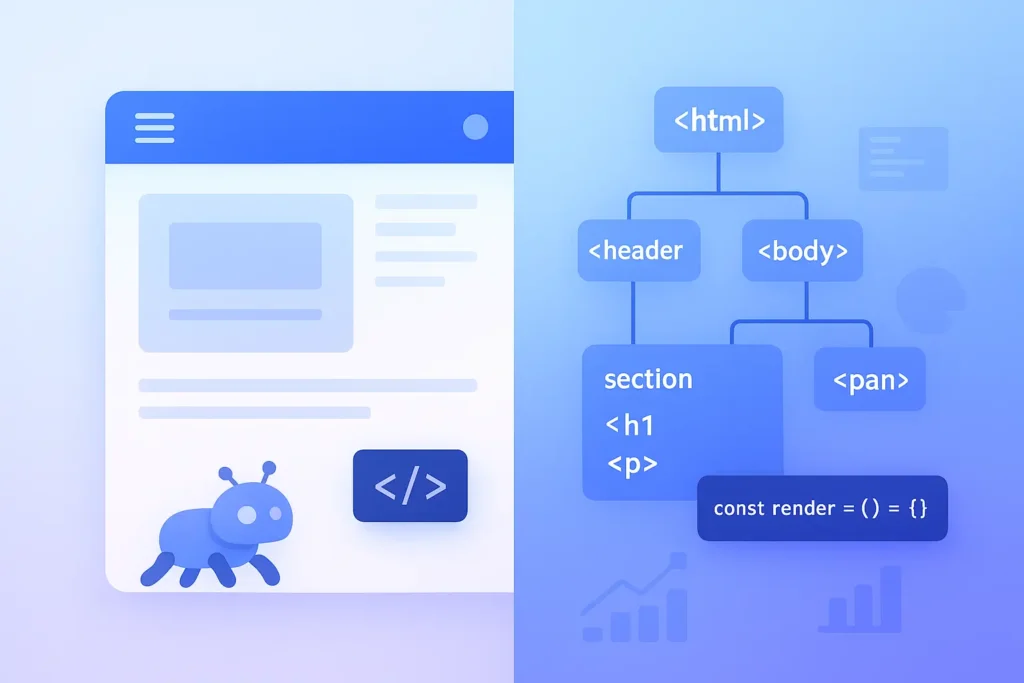Understanding Why JavaScript Rendering Matters
JavaScript controls dynamic content, interactive features, and many of the modern elements that drive the look and feel of a website. But search engines don’t always process JavaScript the same way users do. When scripts fail to render or load properly, crawlers can’t access important text, links, or layout structures. This leads to pages being indexed incorrectly or not indexed at all.
For businesses relying on organic traffic, even small rendering problems can cause ranking drops that go unnoticed for weeks. This is why detecting JavaScript issues early is essential for maintaining healthy visibility.
Common JavaScript-Related Problems That Block Crawlers
Hidden or Delayed Content
If content loads only after client side rendering, crawlers may miss it entirely. This typically happens with heavy frameworks, unoptimized scripts, and long rendering chains. Search engines index what they see, not what you intend to show.
Script Errors That Break the Page
JavaScript errors silently interrupt critical functions. Broken components stop rendering, meaning key modules like navigation, body copy, or product listings may never appear to a crawler.
Improper Use of Lazy Loading
When lazy loading is misconfigured, images and text remain unloaded during crawl time. As a result, crawlers receive a page shell instead of a fully rendered layout.
Blocked Resources
Sometimes files needed for rendering are accidentally blocked in robots.txt or served from third party domains that don’t allow crawling. Without access to scripts and styling assets, Google can’t see the real page.
How SEOsets Identifies JavaScript Rendering Issues
Full DOM and Rendered HTML Comparison
SEOsets compares server side HTML with the fully rendered DOM. Any missing elements, mismatched content, or unrendered components immediately signal JavaScript rendering failure. This comparison uncovers issues like delayed modules, disappearing text, or improperly loaded dynamic sections.
Screenshot Based Crawl Diagnostics
A visual screenshot taken during crawling helps detect layout shifts, broken components, missing banners, or modules that fail to render. If crawlers see a blank or partially loaded page, SEOsets flags the issue instantly.
Script Level Error Tracking
The tool logs console errors, blocked scripts, and resource failures. These reveal the exact cause behind rendering breakdowns, such as dependency conflicts, incorrect script order, or missing files.
Render Time and Crawl Budget Impact Analysis
If JavaScript takes too long to execute, crawlers may stop rendering early. SEOsets identifies slow components, heavy bundles, and render blocking scripts so developers know which parts to fix first.
Mobile and Desktop Rendering Comparison
Crawlers process mobile and desktop pages differently. SEOsets checks both versions to find issues like missing mobile modules, mismatched layouts, or components that only break on certain devices.
How These Findings Help Improve Visibility
Identifying JavaScript rendering failures allows teams to fix indexing issues before rankings suffer. Ensuring that content loads cleanly, scripts don’t break, and crawlers receive the full page helps maintain strong visibility and reliable indexing. With accurate data, developers can focus on the exact elements causing rendering gaps, improving both user experience and search performance.
When You Should Start Monitoring
If your site uses React, Vue, Angular, or any framework that relies heavily on client side rendering, regular monitoring is essential. Sites with frequent updates, ecommerce product filtering, or dynamic category pages are also at high risk for rendering problems. Early detection prevents months of missed visibility.
Final Thought
To analyze your website’s JavaScript rendering health and uncover issues blocking your rankings, explore the full toolset at SEOsets.
FAQs
Why does Google struggle with some JavaScript?
Because Google renders pages in two stages. If scripts are slow, heavy, or error prone, the final content may never reach the index.
Can JavaScript issues affect rankings even without visible errors?
Yes. A page can look perfect to a user but appear incomplete to a crawler. Missing text or modules can lead to indexing gaps.
Do all JavaScript frameworks cause rendering issues?
Not necessarily, but poorly implemented or unoptimized frameworks commonly create problems for crawlers.
How often should I check my site for rendering issues?
At least once a month or after major code changes. Dynamic websites should check more frequently.


